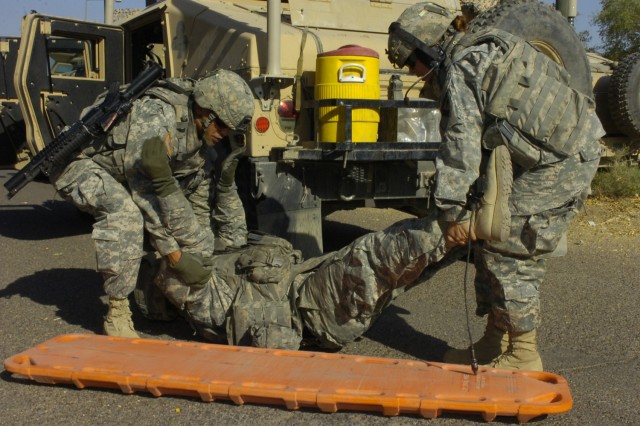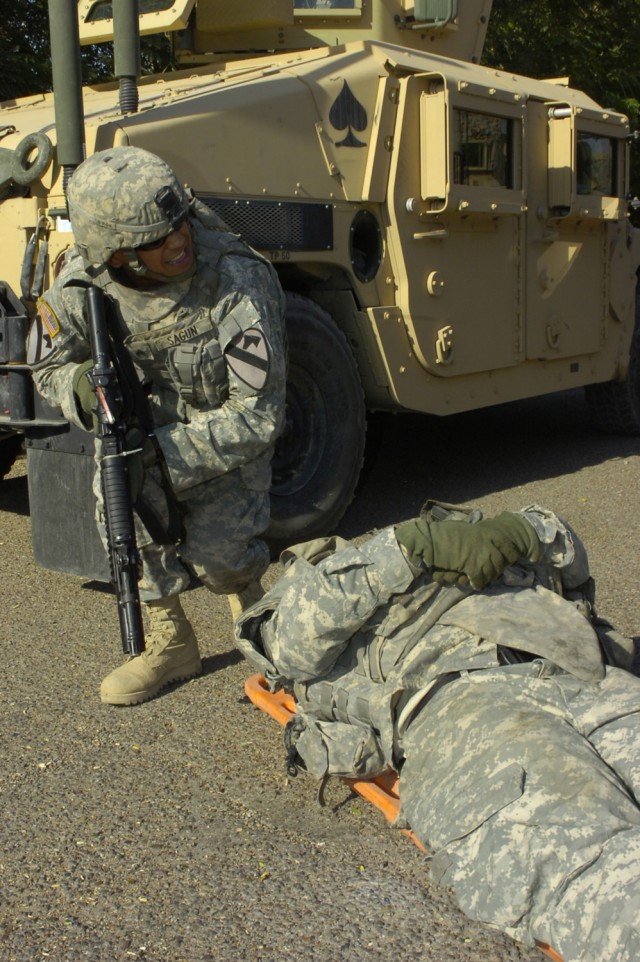BAGHDAD - Standing about 10 feet off to the side of the road, hidden beneath the cover of a thick, overgrown tree line, Sgt. Desmond Steele waits as a small convoy approaches him.
He lets the first truck pass by and focuses his attention on the second one. As it slowly approaches his position, he waits, patiently, until it is almost directly beside him before setting off a simulated, roadside bomb - turning what was a routine mission into a possible life or death situation.
This scenario is part of a lane training exercise, which focuses on combat logistics patrols, that Soldiers of the 15th Brigade Support Battalion "Gamblers," 2nd Brigade Combat Team, 1st Cavalry Division have recently been taking part in.
"It gives them real-life training," explained Steele, the battalion's Operations noncommissioned officer, who played the role of the opposing force during the week-long exercise. "It gives them a chance or opportunity to experience some of the things that are actually going on or some of the things that could happen."
Night after night, Gambler Soldiers are out on the road running the CLPs that move supplies in and around the brigade's area of operations, and although they have been performing this mission for nearly 11 months without any major incidents, the leadership of the battalion believed that conducting a lane training exercise was important for two reasons.
The first goal was to offset any complacency that many have set in from having successfully performed the same mission over such a long period of time, explained Capt. Erin Gilliam, Co. A's commander and the observer controller for the exercise.
"We identified areas that we need to work on - some areas that we've probably loosened up on in terms of our PCCs (Pre-Combat Checks) and PCIs (Pre-Combat Inspection) prior to going out on mission, and I think we've put that thought back into each one of the vehicles and each one of the gun trucks," Gilliam, who is originally from Eatontown, N.J. said.
The exercise also gave some younger Soldiers a chance to try their hand at planning and commanding a CLP - a job usually reserved for senior NCOs or junior officers.
"We've got great sergeants and staff sergeants out there across the battalion, and when they come back next time with Black Jack or somebody else, they're going to be a squad leader or they're going to be platoon sergeants," Capt. Bryan Fencl, the Operations officer for 15th BSB said. "We owe it to those Soldiers, both the officers and the noncommissioned officers, to develop those Soldiers because they're the future of the Army."
Fencl, a native of Mount Laurel, N.J., said that the Soldiers selected as CLP commanders were put in charge of every aspect of the mission from receiving the mission, issuing the orders, conducting rehearsals and, then of course, the execution.
While a typical CLP may be comprised of as many as 30 vehicles, Fencl said they scaled the convoys down to four humvess for the exercise, and then planned a route that would take the convoy throughout the International Zone.
"We came up with this concept of using the International Zone as our terrain for the training," he explained. "We can train it and remove the external threat that we have outside in the red zone but still maintain the same procedures, tactics and techniques that we normally do."
With checkpoints in place and roads full of traffic, Gilliam said that the IZ is probably the most realistic training environment that they could use for this type of exercise.
"It's what we deal with on any other road, and it's just a little bit of a safer environment in which to operate where we can have people dismount yet provide some realism to the mission and to the training event," she said.
Staff Sgt. Heather Shelley, a section sergeant in Co. A's fuel and water platoon, has served as an assistant CLP commander on several occasions, but going through the lane Sept. 26 was her first attempt at commanding a convoy.
She said the biggest difference she had to deal with was the amount of information, both in planning the mission and while conducting it.
"Calling in checkpoints, weapon statuses, talking with other trucks about what they see - there's a constant flow of information coming in at the CC position," Shelley said. "Then once the actions on contact come in, everything goes haywire, and you still have to remain focused on getting that information up because that's your job - the continuity of information between the Soldiers on ground and what battalion needs to know."
She said the mission went very smoothly until near the end, when Steele entered the scenario and took out the vehicle she was riding in with the improvised explosive device that he placed on their route.
With two injured Soldiers and a disabled vehicle on her hands, Shelley quickly moved into another vehicle and got on the radio to take command of the situation.
"I was doing nine-line MEDEVACS, I was simultaneously doing hasty hook-up calls - it was just constant, one right after another and you did not even look at it as a training event," she said. "You look at it as real time and to do that in a safe and controlled environment was probably the most beneficial thing because you realize as a leader your weaknesses and strengths, but you also realize, 'hey this is how it really goes.'"
Shelley said that getting this exposure and practice to commanding a convoy now helps prepare her for her future duties, and Gilliam said that preparing younger Soldiers to lead in the future is one of the most important aspects of training.
"It's phenomenal to see a group of younger Soldiers and sergeants out there who haven't been doing this and who haven't been in the lead, leading from the front," she said. "It gives us a great sense of confidence that our junior NCOs and our junior Soldiers know what it takes to do the job and that they can do it. It's rewarding in all respects."








Social Sharing